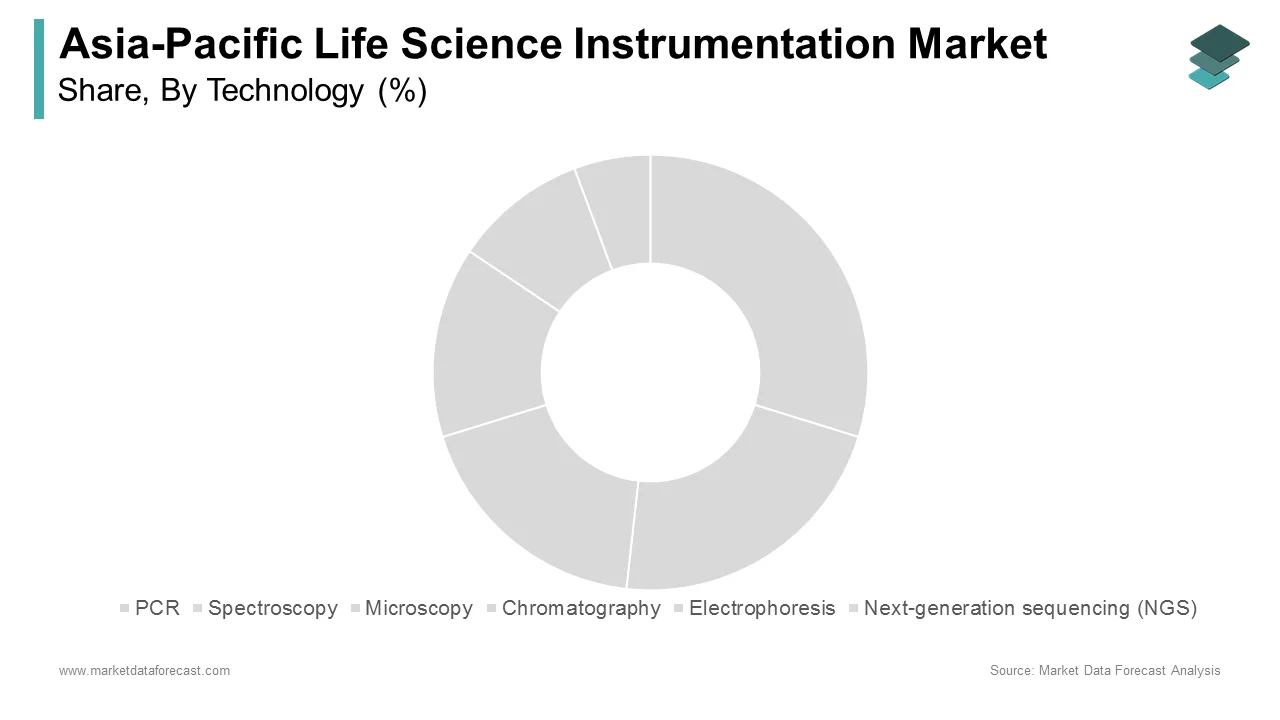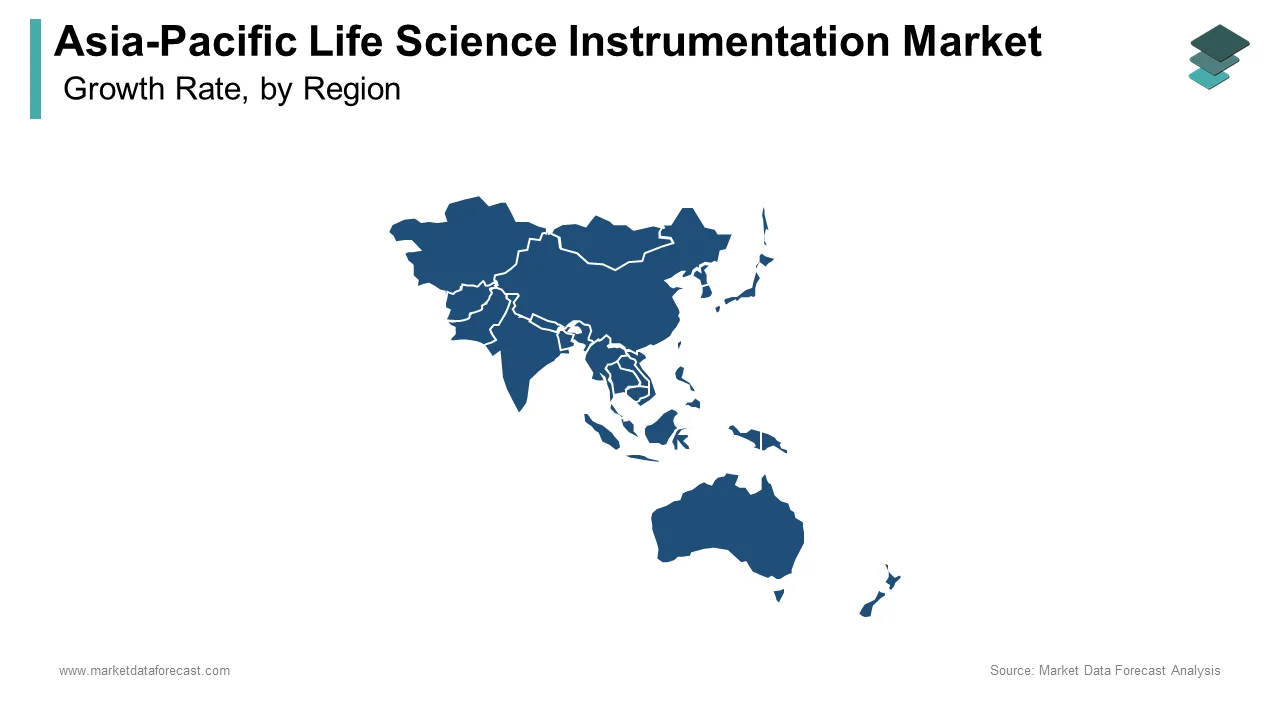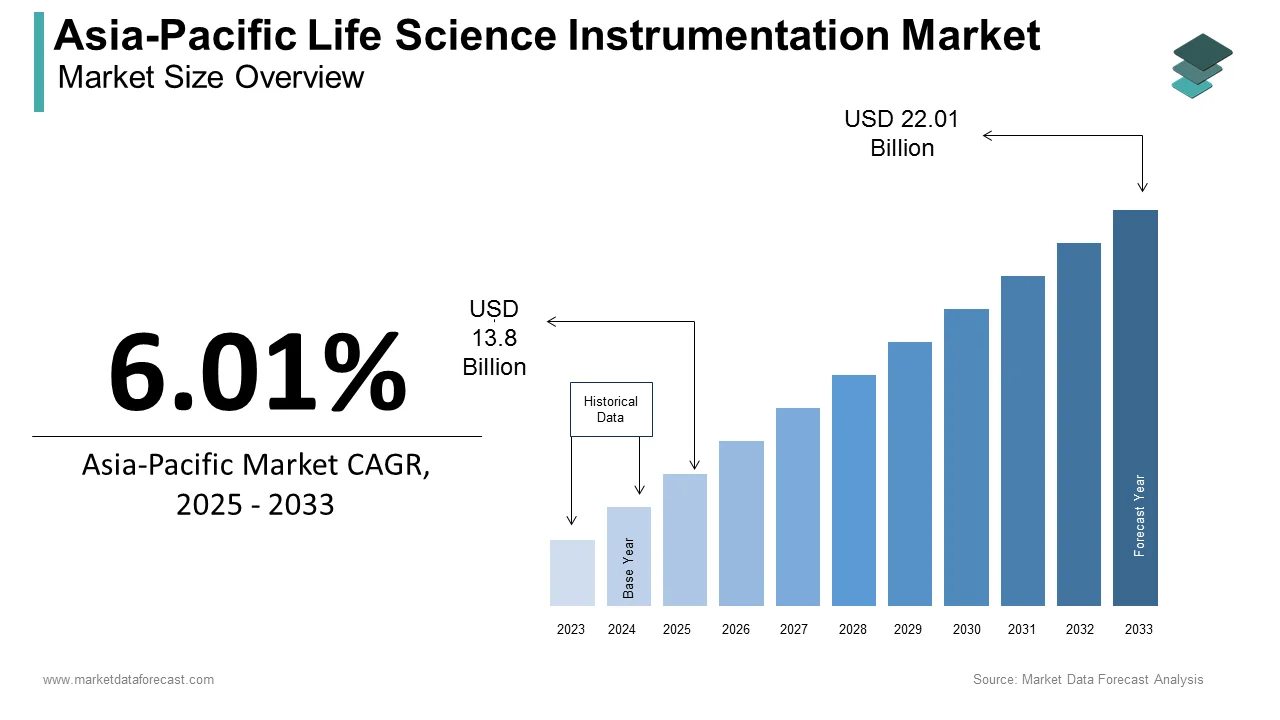Asia-Pacific Life Science Instrumentation Market Size, Share, Trends & Growth Forecast Report By Technology, Application, End-User & Country (India, China, Japan, South Korea, Australia & New Zealand, Thailand, Malaysia, Vietnam, Philippines, Indonesia, Singapore & Rest of Asia-Pacific), Industry Analysis From 2025 to 2033
Asia-Pacific Life Science Instrumentation Market Size
The life science instrumentation market size in Asia-Pacific was valued at USD 13.02 billion in 2024. This regional market is expected to grow at a CAGR of 6.01% from 2025 to 2033 and be worth USD 22.01 billion by 2033 from USD 13.8 billion in 2025.
MARKET DRIVERS
Rising R&D Investments and Advanced Applications Drive Market Growth
Increased spending on research and development, growing public and private financing for life science research, rising demand for analytical instruments, and rising incidence of target diseases and genetic disorders are propelling the expansion of the Asia Pacific market. In addition, the market is advancing due to the increasing adoption of applications such as capillary electrophoresis with mass spectroscopy, flow cytometry techniques, and others.
Furthermore, one of the major factors driving the growth of the life science instrumentation market in Asia-Pacific is the rising frequency of hospital-acquired infections and quick advancements in NGS platforms. In addition, the pharmaceutical industry's increasing investment in drug discovery and development is anticipated to increase the demand for life science tools for drug validation. In the next few years, the Asia Pacific life science instrumentation market will benefit from the severity of chronic diseases and the demand for early detection and treatment.
Growing Health Awareness and R&D Funding Propel Market Growth
Additionally, as people become more aware of the importance of early detection and treatment of chronic diseases, there will be greater demand for life science instruments. The demand for life science instrumentation technology in the pharmaceutical and biotechnology industries is fueled by rising public health awareness and proactive government policies to reduce chronic disease-related mortality. The market is further expected to be driven by rising R&D spending, growing food safety concerns, technological developments in analytical instruments, and the availability of financing for life science research.
MARKET RESTRAINTS
High Costs and Skilled Labor Shortage Restrain Market Growth
On the other hand, unawareness about instruments, insufficient research infrastructure, a scarcity of skilled professionals, and technical limitations associated with qPCR and dPCR techniques, as well as the high cost of advanced microscopes, is projected to pose a negative effect on the growth of the life science instrumentation market in Asia-Pacific. Some of the instruments are incredibly advanced and complex, necessitating the development of novel data computation and information extraction paradigms. These instruments also have regular standardization processes and maintenance procedures, both of which require qualified employees. Furthermore, the high cost of life science and chemical instrumentation restricts the market's expansion.
SEGMENT ANALYSIS
By Technology Insights

COUNTRY LEVEL ANALYSIS
The Asia Pacific region is a significant revenue generator in the global life science instrumentation market. Strategic expansions by the key market participants in emerging Asian nations, the growing pharmaceutical market in India and China, and conferences, displays, and symposia on analytical instruments are promoting this regional market growth. Due to increased research activities in countries such as India, the Asia-Pacific market is expected to grow at a high CAGR during the forecast period. In addition, increasing public-private investments in life science research and technological advancements in analytical equipment drive the market for life science instruments and chemicals. Heart and brain disorders, such as Alzheimer's disease, constitute a significant threat to society. This increase in burden is attributable to population growth, rapid aging, and a shift in emerging countries from poverty-related diseases to lifestyle diseases. Furthermore, expanding healthcare facilities in emerging economies such as China, India, and other nations create a considerable demand for life science instruments, contributing to the market's growth.

KEY MARKET PLAYERS
Danaher, Thermo Fisher Scientific, Inc., Merck KGaA, Bio-Rad Laboratories, Inc., Agilent Technologies, Inc., Illumina, Inc., PerkinElmer, Inc., BD, Bruker, and Hitachi High-Technologies Corporation are some of the notable companies in the life science instrumentation market in the Asia Pacific region and profiled in this report.
MARKET SEGMENTATION
This research report on the Asia Pacific life science instrumentation market has been segmented and sub-segmented based on the technology, application, end-user, and region.
By Technology
- PCR
- Spectroscopy
- Microscopy
- Chromatography
- Electrophoresis
- Next-generation sequencing (NGS)
- Flow Cytometry
- Centrifuges
- Others
By Application
- Clinical and Diagnostic
- Research
- Others
By End-user
- Hospitals and diagnostic laboratories
- Pharmaceutical and biotechnology companies
- Academic & Research institutions
- Others
By Country
- India
- China
- Japan
- South Korea
- Australia
- New Zealand
- Thailand
- Malaysia
- Vietnam
- Philippines
- Indonesia
- Singapore
- Rest of Asia Pacific
Related Reports
Access the study in MULTIPLE FORMATS
Purchase options starting from
$ 2000
Didn’t find what you’re looking for?
TALK TO OUR ANALYST TEAM
Need something within your budget?
NO WORRIES! WE GOT YOU COVERED!
Call us on: +1 888 702 9696 (U.S Toll Free)
Write to us: sales@marketdataforecast.com

